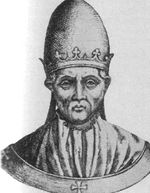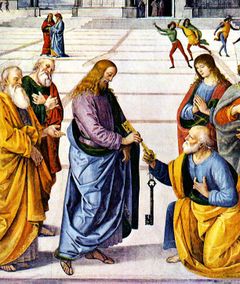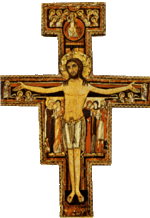Pope Celestine V
| Celestine V | |
|---|---|
 |
|
| Papacy began | July 7, 1294 |
| Papacy ended | December 13, 1294 |
| Predecessor | Nicholas IV |
| Successor | Boniface VIII |
| Personal details | |
| Birth name | Pietro Angelerio |
| Born | 1209 near Isernia, Kingdom of Sicily |
| Died | May 19, 1296 Ferentino, Papal States |
| Sainthood | |
| Feast day | May 19 |
| Other Popes named Celestine | |
| Papal styles of Pope Celestine V |
|
|---|---|
 |
|
| Reference style | His Holiness |
| Spoken style | Your Holiness |
| Religious style | Holy Father |
| Posthumous style | Saint |
Pope Saint Celestine V (c. 1209 – 19 May 1296), born Pietro Angelerio (according to some sources Angelario, Angelieri, Angelliero, or Angeleri), also known as Pietro da Morrone, was elected pope in the year 1294, by the Papal election, 1292–1294, the last non-conclave in the history of the Roman Catholic Church. Celestine V is recognized by the Church as a saint. No subsequent Pope has taken the name "Celestine".
Contents |
Birth
According to a tradition, he was born in 1209 in the village of Sant'Angelo Limosano, in Molise, the son of Angelo Angelerio and Maria Leone. Recently, the towns of Isernia and Sant'Angelo in Grotte, have been mentioned as his possible birthplaces. His date of birth has been also assigned to 1215.
Early Life
After his father's death he started to work in the fields. His mother Maria was a key figure in Pietro's spiritual development: she imagined a different future for her deeply beloved son than just becoming a farmer or a shepherd. From the time he was a child, he showed great intelligence, and love for his fellow beings. He became a Benedictine monk at Faifoli in the diocese of Benevento when he was seventeen. He showed an extraordinary disposition toward asceticism and solitude, and in 1239 retired to a solitary cavern on the mountain Morrone, whence his name. Five years later he left this retreat, and betook himself, with two companions, to a similar cave on the Mountain of Maiella in the Abruzzi region of south Italy, where he lived as strictly as was possible according to the example of St. John the Baptist. Terrible accounts are given of the severity of his penitential practices. While living in this manner he founded, in 1244, the order subsequently called after him, the Celestines.
Papacy
The cardinals assembled at Perugia after the death of Pope Nicholas IV (1288–92) in April 1292. Morrone, well known to the cardinals as a Benedictine hermit, sent the cardinals a letter warning them that divine vengeance would fall upon them if they did not quickly elect a Pope. Latino Malabranca, the aged and ill dean of the College of Cardinals cried out, "In the name of the Father, the Son, and the Holy Ghost, I elect brother Pietro di Morrone." The cardinals promptly ratified Malabranca's desperate decision. When sent for, Morrone obstinately refused to accept the Papacy, and even, as Petrarch says, attempted flight, until he was at length persuaded by a deputation of cardinals accompanied by the Kings of Naples and Hungary. Elected July 7, 1294, he was crowned at S. Maria di Collemaggio in the city of Aquila (now called L'Aquila) in the Abruzzi, August 29, taking the name of Celestine V.
Shortly after assuming office Celestine issued a papal bull granting a rare plenary indulgence to all pilgrims visiting Santa Maria di Collemaggio through its holy door on the anniversary of his papal coronation.[1] The Perdonanza Celestiniana festival is celebrated in L'Aquila every August 28–29 in commemoration of this event.[2]
His notable acts as pope include (in what seems to be the only instance of such an act in the history of the Church) empowering one Francis of Apt, a Franciscan friar, to confer the clerical tonsure and minor orders on Lodovico (who would later become Bishop of Toulouse), the son of the King of Sicily. However, this decree seems not to have been carried out. He issued two other decrees—one confirming that of Pope Gregory X (1271–76), which orders the shutting of the cardinals in conclave; the second declaring the right of any Pope to abdicate the Papacy—a right that he himself exercised, at the end of five months and eight days, at Naples on December 13, 1294. In the formal instrument of his renunciation he recites as the causes moving him to the step, "the desire for humility, for a purer life, for a stainless conscience, the deficiencies of his own physical strength, his ignorance, the perverseness of the people, his longing for the tranquility of his former life"; and having divested himself of every outward symbol of dignity, he retired to his old solitude.
Retirement
Celestine V was not allowed to remain in solitude, however. His successor, Pope Boniface VIII (1294–1303), sent for him, and finally, despite the former Pope's desperate attempts to escape, captured him and imprisoned him in the castle of Fumone near Ferentino in Campagna, where, after languishing for ten months in that infected air, he died on May 19, 1296. Some historians[3] believe Boniface might have had him murdered, and indeed his skull does have a suspicious hole.[4] Pope Clement V canonized Celestine in 1313 at the urging of Philip IV of France who saw it as an opportunity to demean Pope Boniface VIII whom Philip despised. He was buried at Ferentino, but his body was subsequently removed to the Basilica Santa Maria di Collemaggio in Aquila.
Legacy
Most modern interest in Celestine V has focused on his decision to resign the papacy.[5] A 1966 visit by Pope Paul VI (1963–1978) to Celestine's place of death in Ferentino along with his speech[6] in homage of Celestine prompted speculation the pontiff was considering retirement.[7] Celestine's remains survived the 2009 L'Aquila earthquake, with one Italian spokesman saying it was another great miracle by the pope[8], and were then recovered from the basilica shortly after the earthquake.[9] While inspecting the earthquake damage during an April 28, 2009 visit to the L'Aquila, Pope Benedict XVI (2005–present) visited Celestine's remains in the badly damaged Santa Maria di Collemaggio and left the woolen pallium he wore during his papal inauguration in April 2005 on his glass casket as a gift.[10] To mark the 800th anniversary of Celestine's birth, Pope Benedict XVI proclaimed the Celestine year from August 28, 2009 through August 29, 2010.[11]
In literature
A persistent tradition identifies Celestine V as the nameless figure Dante sees among those in the antechamber of Hell, in the enigmatical verses: "I saw and recognized the shade of him Who by his cowardice made the great refusal" (Inferno, III, 59–60) The first commentators to make this identification included Dante’s son Jacopo Alighieri, [Jacopo Alighieri, Chiose all'«Inferno», 1990, p. 100] followed by Graziolo Bambaglioli in 1324. The identification is also considered probable by recent scholars (e.g. Hollander, Barbara Reynolds, Simonelli, Padoan). Petrarch was moved to defend Celestine vigorously against the accusation of cowardice and some modern scholars (e.g. Mark Musa) have suggested Dante may have meant someone else (Esau, Diocletian and Pontius Pilate have been variously suggested).
Pope Celestine V is referenced in Chapter 88 of Dan Brown's Angels & Demons. He is referenced as an example of a murdered pope. Celestine V is also mentioned in the film version.
The life of Pope Celestine V is dramatised in the plays L'avventura di un povero cristiano (The Story of a Humble Christian) by Ignazio Silone in 1968 and Sunsets and Glories by Peter Barnes in 1990.
Pope Celestine V's story is also told in Russell Chamberlin's The Bad Popes.
References
- ↑ Pope, John Paul II (23 August 2001). "ADDRESS OF JOHN PAUL II TO THE JURY MEMBERS OF THE "PREMIO INTERNAZIONALE PERDONANZA"". http://www.vatican.va/holy_father/john_paul_ii/speeches/2001/august/documents/hf_jp-ii_spe_20010823_perdonanza_en.html.
- ↑ "The Perdonanza". Abruzzo Heritage. Summer 2002. http://www.abruzzoheritage.com/magazine/2002_05/f.htm.
- ↑ "Medieval pope slain, monk says" (in English). ASSOCIATED PRESS (Austin American Statesmen). August 23, 1998. http://nl.newsbank.com/nl-search/we/Archives?p_product=AASB&p_theme=aasb&p_action=search&p_maxdocs=200&p_topdoc=1&p_text_direct-0=0EA07674B2438A37&p_field_direct-0=document_id&p_perpage=10&p_sort=YMD_date:D&s_trackval=GooglePM. Retrieved 26 December 2009.
- ↑ Celestine V
- ↑ Petre, Jonathan (8 February 2005). "Cardinal hints that ailing Pope may resign". The Telegraph. http://www.telegraph.co.uk/education/3350359/Cardinal-hints-that-ailing-Pope-may-resign.html.
- ↑ Pope, Paul VI (1 September 1966). "Homage to St. Celestine V". http://www.vatican.va/holy_father/paul_vi/speeches/1966/documents/hf_p-vi_spe_19660901_s-celestino-v_it.html.
- ↑ "Roman Catholicism: Retirement for 200 Bishops". Time Magazine. 30 September 1966. http://www.time.com/time/magazine/article/0,9171,836464,00.html.
- ↑ Pope's bones survive earthquake
- ↑ Kington, Tom (14 April 2009). "Italy earthquake focus shifts to saving Abruzzo's heritage". The Guardian. http://www.guardian.co.uk/world/2009/apr/14/italian-earthquake-damage.
- ↑ Owen, Richard (28 April 2009). "Pope Benedict XVI visits Abruzzo earthquake zone to pray for victims". The Times. http://www.timesonline.co.uk/tol/comment/faith/article6184757.ece.
- ↑ Bertone, Tarcisio (28 August 2009). "Homily of Card. Tarcisio Bertone for the opening of the Holy Door on the occasion of the Feast of Celestinian Forgiveness and the beginning of the Celestinian Year". http://www.vatican.va/roman_curia/secretariat_state/card-bertone/2009/documents/rc_seg-st_20090828_anno-celestiniano_it.html.
External links
 "Pope St. Celestine V". Catholic Encyclopedia. 1913.
"Pope St. Celestine V". Catholic Encyclopedia. 1913.- A short video outlining the life of Pope Celestine V.
- Pictures of Pope Benedict XVI's visit to the tomb of Celestine V
| Catholic Church titles | ||
|---|---|---|
| Preceded by Nicholas IV |
Pope 1294 |
Succeeded by Boniface VIII |
|
|||||||||||||||||||||||||||||||||||||||||
|
|||||||||||||||||||||||||||||||||||||||||||||

